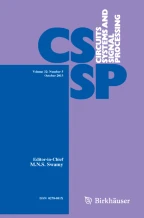Abstract
Image distortion can be categorized into two types: content-dependent degradation and content-independent one. Most of the existing perceptual full-reference image quality assessment (IQA) metrics cannot deal with both these two different impacts well. Singular value decomposition (SVD) as a useful mathematical tool that has been used in various image processing applications (e.g., feature extraction). In this paper, SVD is employed to decompose the images into the structural (content-dependent) and the content-independent components. For each portion, a specific assessment model is designed to tailor for its corresponding distortion properties. All the proposed models are then fused to obtain a final quality score by extreme learning machine (ELM), a machine learning technique. Extensive experimental results on six publicly available databases demonstrate that the proposed metric achieves better performance in comparison with the relevant state-of-the-art quality metrics.
Similar content being viewed by others
References
P. Bartlett, S. Boucheron, G. Lugosi, Model selection and error estimation. Mach. Learn. 48(1–3), 85–113 (2002)
D.M. Chandler, S.S. Hemami, VSNR: a wavelet-based visual signal-to-noise ratio for natural images. http://foulard.ece.cornell.edu/dmc27/vsnr/vsnr.html. Accessed 13 Aug 2007
S.S. Channappayya, A.C. Bovik, R.W. Heath, Rate bounds on SSIM index of quantized images. IEEE Trans. Image Process. 17(9), 1624–1639 (2008)
S.S. Channappayya, A.C. Bovik, R.W. Heath, Rate bounds on SSIM index of quantized images. IEEE Trans. Circuits Syst. Video Technol. 20(11), 1614–1624 (2010)
Final report from the video quality experts group on the validation of objective models of video quality assessment II (2003). Video Quality Expert Group (VQEG). http://www.vqeg.org/. Accessed Mar 2003
Y. Horita, K. Shibata, Y. Kawayoke, Z.M.P. Sazzad, Image Quality Evaluation Database. http://mict.eng.u-toyama.ac.jp/database_toyama/. Accessed 2000
G.B. Huang, Q.Y. Zhu, C.K. Siew, Extreme learning machine: theory and applications. Neurocomputing 70, 489–501 (2006)
G.B. Huang, L. Chen, C.K. Siew, Siew, Universal approximation using incremental constructive feedforward networks with random hidden nodes. IEEE Trans. Neural Netw. 17(4), 879–892 (2006)
E.C. Larson, D.M. Chandler, Categorical image quality (csiq) database. http://vision.okstate.edu/csiq. Accessed 7 Jan 2010
E.C. Larson, D.M. Chandler, Most apparent distortion: full-reference image quality assessment and the role of strategy. J. Electron. Imaging 19(1), 011006:1–011006:21 (2010)
S. Li, F. Zhang, L. Ma, N. King, Image quality assessment by separately evaluating detail losses and additive impairments. IEEE Trans. Multimed. 13(5), 935–949 (2011)
A. Liu, W. Lin, M. Narwaria, Image quality assessment based on gradient similarity. IEEE Trans. Image Process. 21(4), 1500–1512 (2012)
W. Liu, W. Lin, Additive white Gaussian noise level estimation in SVD domain for images. IEEE Trans. Image Process. 22(3), 872–883 (2013)
Methodology for the subjective assessment of the quality of television picture, IEEE Std. Recommendation ITU-R BT.500-11 (2002)
M. Narwaria, W. Lin, SVD-based quality metric for image and video using machine learning. IEEE Trans. Syst. Man, and Cybern. 42(2), 347–364 (2012)
A. Ninassi, P.L. Callet, F. Autrusseau, Pseudo non-reference image quality metric using perceptual data hiding, in SPIE Human Vision and Electronic Imaging, vol. 6057–08 (San Jose, 2006)
N. Ponomarenko, K. Egiazarian, Tampere image database 2008 tid2008. http://www.ponomarenko.info/tid2008.htm. Accessed Jan 2009
H.R. Sheikh, K. Seshadrinathan, A.K. Moorthy, Z. Wang, A.C. Bovik, L.K. Cormack, MICT Image and video quality assessment research at live. http://live.ece.utexas.edu/research/quality/. Accessed 18 Mar 2006
H.R. Sheikh, A.C. Bovik, Image information and visual quality. IEEE Trans. Image Process. 15(2), 430–444 (2006)
S. Wang, C. Deng, W. Lin, B. Zhao, A novel SVD-based image quality assessment metric, in Proc. Int. Conf. Image Process, Melbourne, 2013
Z. Wang, E.P. Simoncelli, A.C. Bovik, Multi-scale structural similarity for image quality assessment, in Proc. IEEE Asilomar Conf. Signals, Syst., Comput., Pacific Grove, 2003, pp. 1398–1402
Z. Wang, A.C. Bovik, H.R. Sheikh, E.P. Simoncelli, Image quality assessment: from error visibility to structural similarity. IEEE Trans. Image Process. 13(4), 600–612 (2004)
Z. Wang, A. Bovik, Mean squared error: love it or leave it? IEEE Signal Process. Mag. 26(1), 99–117 (2009)
Z. Wang, Q. Li, Information content weighting for perceptual image quality assessment. IEEE Trans. Image Process. 20(11), 1614–1624 (2010)
J. Wu, W. Lin, G. Shi, A. Liu, A perceptual quality metric with internal generative mechanism. IEEE Trans. Image Process. 22(1), 43–54 (2013)
L. Zhang, L. Zhang, X. Mou, D. Zhang, FSIM: a feature similarity index for image quality assessment. IEEE Trans. Image Process. 20(8), 2378–2386 (2011)
J. Zhu, N. Wang, Image quality assessment by visual gradient similarity. IEEE Trans. Image Process. 21(3), 919–933 (2012)
Author information
Authors and Affiliations
Corresponding author
Rights and permissions
About this article
Cite this article
Wang, S., Cui, D., Wang, B. et al. A Perceptual Image Quality Assessment Metric Using Singular Value Decomposition. Circuits Syst Signal Process 34, 209–229 (2015). https://doi.org/10.1007/s00034-014-9840-3
Received:
Revised:
Accepted:
Published:
Issue Date:
DOI: https://doi.org/10.1007/s00034-014-9840-3
